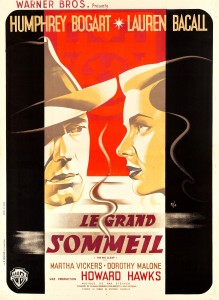I’m ashamed to admit that I didn’t discover Lauren Bacall until my early 20s. I know that I must have seen at least one of her movies before then, but the first clear memory I have of connecting with her work is watching The Big Sleep when I was 23. I didn’t know it at the time, but she was only 21 when it was filmed. I was struck with her presence. Yes, the studio had altered Raymond Chandler’s novel to make her character a more acceptable romantic lead – in the novel her character is more unambiguously a femme fatale – but she still exudes power with every sultry, knowing look. Unlike the Hitchcock blondes I idolized at the time, Bacall was more than just spunky. She knew exactly what she was doing and why. As I learned later, she was one of the last of a long line of strong female stars produced by the classical Hollywood studio system. The system may have been dominated by male producers and directors who exercised tight control over all of their stars – male and female – but those men still realized that women made up the largest part of their audience. Women like Bette Davis and Barbara Stanwyck enjoyed long careers as strong, independent women. As scholars like Jeanine Basinger have pointed out, even if Depression-era women’s films ended with a conservative message of family togetherness and female submission, they depicted women grappling with difficult issues and often making rebellious choices, thereby validating their right to choose.[1] The post-war noirs that Bacall starred in are often characterized as reactionary and male-centric, but many still acknowledged and validated women’s desire for independence and fear of male violence. What I saw in Bacall’s roles, including To Have and Have Not, but even weaker films like Dark Passage, was a young woman struggling to determine her own destiny – and maybe enjoy a few adventures alongside the man she loved – in a society that wanted her to stay at home, where she’d be safe. Sure, she could be quiet and submissive when she needed to be, but her eyes always spoke of a deeper rebellion against society’s stifling expectation. She was never sweet. At the time, all I knew when I was 23 was that she was refreshingly direct and bold, and I felt that my adolescence would have been richer if I’d had her as a role model. She is the standard by which I’ve judged every strong female role since.
I didn’t spend much time studying Bacall’s biography when I first discovered her. I learned that she and Humphrey Bogart were married, which helped to complete my image of her as an independent woman who could still have it all, but – to be perfectly honest – I was afraid that I would be disappointed if I knew what she was like in real life. Stars so often disappoint, and I try to let actors’ work speak for itself. In the end though, I don’t think I needed to worry so much. Yes, I wish she – and the rest of Hollywood – would have stuck by their principles instead of backing down on their objections to HUAC and the blacklist, but I also understand that people crack under intense pressure. Bacall’s film career may not have been as prolific as it should have been. Even before the studio system’s decline hurt other strong female stars, Bacall appeared to knock heads with studio heads – I learned from her New York Times obituary that Warner Brothers suspended her twelve times for rejecting scripts.[2] Still, she continued to work in films and on the stage for most of her life, and she advocated for liberal political causes. All in all, not a bad life. And really, I don’t know how much I can really be disappointed in someone who famed old-biddy gossip columnist Louella Parsons once castigated for encouraging juvenile delinquency by talking about her “gang” of friends.
-Catherine Martin

This was such a fantastic read! Its clear you put a lot of efforts.